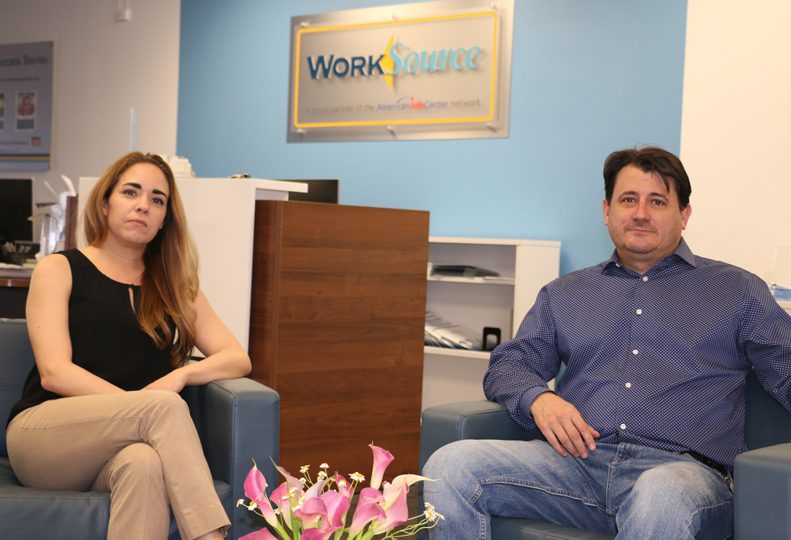
Home » Worksource staff makes virtual transition
Worksource staff makes virtual transition
Employment workers got early jump on virus

April 23, 2020
In just four days, Spokane’s employment and worker training agency WorkSource moved its entire staff of 125 workers home as coronavirus began its march across the state.
All staff was set up and working remotely before a three-week span that saw 32,215 initial unemployment claims submitted by newly laid off Spokane County residents, says WorkSource director Kevin Williams.
Williams and Dawn Karber, Spokane Workforce Coun–cil’s chief operating officer, now are the only occupants in the 40,000-square-foot WorkSource center, at 130 S. Arthur.
From there, Karber and Williams coordinate and plan with their other employment partners both here and around the state.
WorkSource is a conglomeration of employment specialists from employment agency Career Path Services, the Washington state Employment Security Department, Community Colleges of Spokane, the state Department of Labor and Industries, and its Department of Social and Health Services and its Division of Vocational Rehabilitation.
The WorkSource campus serves roughly 8,000 customers annually. WorkSource staff typically doesn’t handle unemployment insurance claims, however, a significant part of staff has been redirected to claims handling to address the high number of claims, Williams says.
“I’m really proud of how fast staff has adjusted to the change on relatively short notice,” Williams says.
“We were a little forward-thinking in recognizing that probably not having staff on site was most likely going to be an option we’d have to look at,” Williams says.
It’s clearly not normal, everyday operations for the center.
“The model has always been one where folks come to the WorkSource office to receive career coaching and other services,” he says.
Despite clear signage indicating the center is closed, at least a half-dozen people show up daily looking for help, they say.
WorkSource staff received immediate crash courses on how to use all forms of teleservices to meet the needs of customers effectively.
“Through Skype, through Zoom, whatever is most comfortable for the customer,” he says. “It’s all just straight tele-work.”
Customers now call WorkSource’s main telephone line and are then connected to the appropriate WorkSource official to help with assistance. WorkSource staff doesn’t handle claims for unemployment insurance.
Williams says department managers stay in close contact with their teams through the same communications channels they use with customers.
Managers have daily virtual huddles with staff in the mornings before business hours, Williams says.
As for WorkSource’s Talent Solutions Team, Williams says its team members have had to make a “huge adapt” to the current economic climate.
Last year, in its ongoing shift to modernize, WorkSource revamped the eight-member Talent Solutions Team so it would have more engagement with businesses in order to help them find appropriate talent.
Previously known as the Business Engagement Team, and before that, the Business Services Team, those units had more contact with job seekers and tried to place them with employers.
Talent Solutions Team members are charged with knowing the culture of the businesses they serve in an effort to help cut down on costly turnover, Williams says.
“The businesses are now laying off,” he says. “So instead of presenting solutions for hiring, they’re now talking to them about some of the programs that are out there, like SharedWork.”
SharedWork is an Employment Security Department program designed to offer flexibility to business operators to retain employees at reduced hours.
“There are programs out there like that that they can speak to the employers about to give them options prior to instituting a large layoff,” he says.
Williams says, well before the spread of COVID-19 in Washington state, WorkSource offered an online service called Career Quest through a website designed to help job seekers locate employment.
Career Quest offers a career planning guide and, a job log tracker, shares advice on interviewing techniques, and presents tips for creating an effective resume, he says.
“We’ve also been able to move many of our previously live, in-house workshops online,” he says.
Karber says she isn’t surprised by what she describes as the near-seamless transition WorkSource staff has made during the coronavirus pandemic.
WorkSource Spokane recently was recognized as the most innovative workforce region in the U.S. by the National Association of Workforce Boards, she says.
That organization recognized the Spokane Workforce Council with its Workforce Innovation and Opportunity Act Trailblazer Award for 2020, which honors the workforce group that has “made the most progress” in adopting the changes envisioned in the act.
“Our staff has definitely stepped up during this challenging time to meet the needs of our economy, and I can absolutely see why they were selected as staffing the most innovative region in the country,” Karber says.
As part of the WorkSource system’s continuous innovation, Karber says the Spokane Resource Center, housed on the second floor at WorkSource, also has been moved entirely online.
Those needing information about food banks and other meal sites can go to spokaneresourcecenter.org for assistance, Karber says.
“We are finding that a larger-than-normal number of individuals are needing access during this difficult time to information about community resources,” she says.
Next Generation Zone activity is also held exclusively online.
“We’re offering online classes so students can finish the GED program that they’ve started,” she says. “We’ve started with Facebook Live and are exploring other platforms that will work best to keep students engaged. But so far, we’ve not seen a drop off in student engagement.”
Latest News Up Close Government
Related Articles



